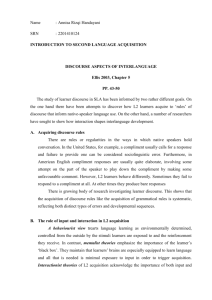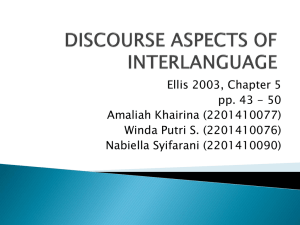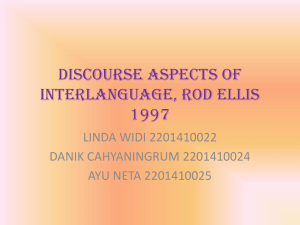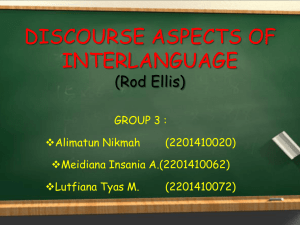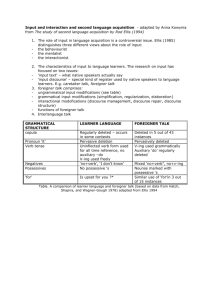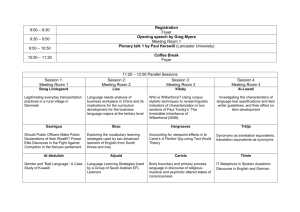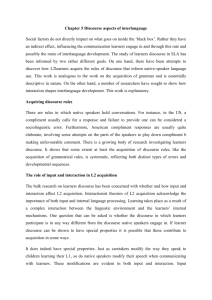discourse aspects of interlanguage
advertisement
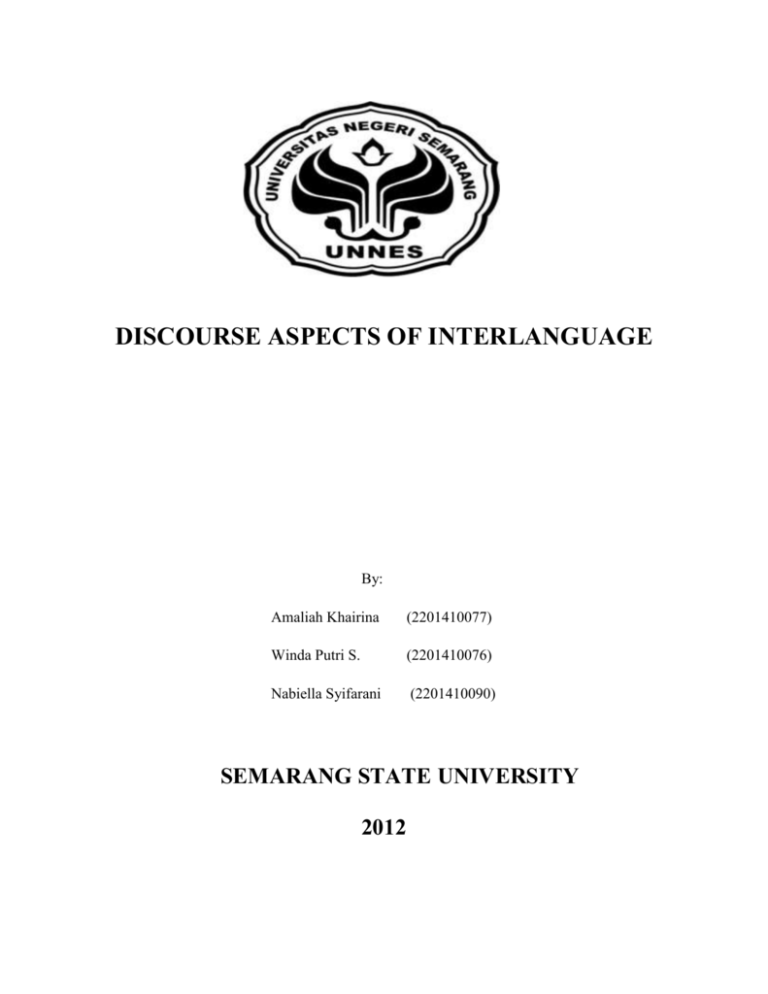
DISCOURSE ASPECTS OF INTERLANGUAGE By: Amaliah Khairina (2201410077) Winda Putri S. (2201410076) Nabiella Syifarani (2201410090) SEMARANG STATE UNIVERSITY 2012 DISCOURSE ASPECTS OF INTERLANGUAGE The study of learner discourse in SLA has been informed by two rather different goals. On the one hand, there have been attempts to discover how L2 learners acquire the ‘rules’ of discourse that inform native – speaker language use. On the other hand, a number of researchers have sought to show how interaction shapes interlanguage development (i.e. how discourse influences the kinds of errors learners make and the developmental orders and sequences they pass through). Acquiring Discourse Rules There are rules or regularities in the ways in which native speaker hold conversations. In the Unites States, for example, a compliment usually calls for a response and failure to provide one can be considered a sociolinguistic error. Furthermore, in American English, compliment responses are usually quite elaborate, involving some attempt on the part of the speaker to play down the compliment by making some unfavorable compliment. For example: A: I like your sweater. B: It’s so old. My sister bought it for me in Italy some time ago. However, L2 learners behave differently. Sometimes, they fail to respond to a compliment at all. At other times, they produce bare responses, for instance, ‘thank you’. The Role of Input and Interaction in L2 Acquisition The bulk of the research on learner discourse has been concerned with whether and how input and interaction affect L2 acquisition. Interactionist theories of L2 acquisition acknowledge the importance of both input and internal language processing. Learning takes place as a result of complex interaction between the linguistic environment and the learner’s internal mechanisms. Input modifications have been investigated through the study of foreigner talk, the language that native speakers use when addressing non – native speakers. Two types of foreigner talk can be identified – ungrammatical and grammatical. Foreigner talk is socially marked it often implies a lack of respect on the part of the native speaker Ungrammatical foreigner talk is characterized by the deletion of certain grammatical features such as copula be, modal verb and articles, the use of the base form of the verb in place of the past tense form and the use of the special constructions such as ‘no+verb’. Various types of modification of baseline talk (i.e. the kind of talk native speakers address to other native speakers) can be identified : 1. First, grammatical foreigner talk is delivered at a slower pace. 2. Second, the input is simplified. 3. Third, grammatical foreigner talk is sometimes regularized 4. Fourth, foreigner talk sometimes consists of elaborated language use Type of talk Example Baseline talk You won’t forget to buy the ice cream on your way home, will you? Ungrammatical foreigner talk No forget buying ice-cream,eh? Grammatical foreigner talk The ice-cream- You will not forget to buy it on your way home – Get it when you are coming home.All right? Research shows that learners sometimes do this. Learners can signal that they have not understood.The result in interactional modifications as the participations as the participants in the discourse engage in the negotiation of meaning. There is plenty evidance to suggest that modified interaction of this kind is common in learnear discourse. Hiroki : A man is uh.dringking c-coffee or tea with uh the saucer of the uh uh coffee set is uh in his uh knee. Izumi : in him knee Hiroko : uh on his knee Izumi : yeah Hiroko : on his knee Izumi : so sorry, on his knee According to Stephen Krashen’s input hypothesis, L2 acquisition takes place when a learner understands input that contains grammatical forms that are at ‘i + I’. Krashen suggests that the right level of input is attained automatically when interlocutors succed in making themselves understood in communication. Michael Long There is another way in which interaction may assist learner. When learners have the chance to clarify something that has been said they are giving themselves more time to process the input, which may help them. Interaction can overload learners with input, as when a speaker provides lengthy paraphrases or long definition of unknown word. Acquisition might be impended rather than facilitated. Evelyn Hatch Hatch emphasize that the collaborative endeavours of the learners and their interlocutors in constructing discourse and suggests that syntactic structure can grow out of the process of building discourse. One way in which this can occur is through scaffolding. Learners use the discourse to help them produce utterances that they would not be able to produce on their own. L.S Vygotsky The two keys contracts in what is known as activity theory are motive and internalization. Vygotsky argues that children learn through interpersonal activity. Vygotsky argues that children learn through interpersonal activities. The zone of proximal development (in Russian: зона ближайшего развития), often abbreviated ZPD, is the difference between what a learner can do without help and what he or she can do with help. It is created through interaction with more knowledgeable others. According to activity theory, socially constructed L2 language is a necessary condition for interlanguage development. The Role of Output in L2 acquisition Discourse supplies learners with the opportunity to produce language as well as hear it. Krashen Speaking is the result of acquisition, not its cause. The only way learner can learn from their output is by treating it as auto-input. Merrill Swain He suggests that a number of specific ways in which learners can learn from their own output. Output can serve a consciousness raising function by helping learner to notice gaps in their interlanguage. Second, They can try out a rule and see whether it leads to successful communication or whether it elicits negative feedback. Third, learners sometimes talk about their own output. Conclusion There are a number ways in which discourse might contribute to second language acquisition, there are through the modified input that comes in foreign talk, through the input learners obtain from the negotiation of meaning, through scaffolding, and through comprehensible output.
